Attached files
| file | filename |
|---|---|
| 8-K - 8-K - Synchrony Financial | a8-k4q152416quarterlyinves.htm |

2015 Fourth Quarter Investor Presentation February 4, 2016 Exhibit 99.1
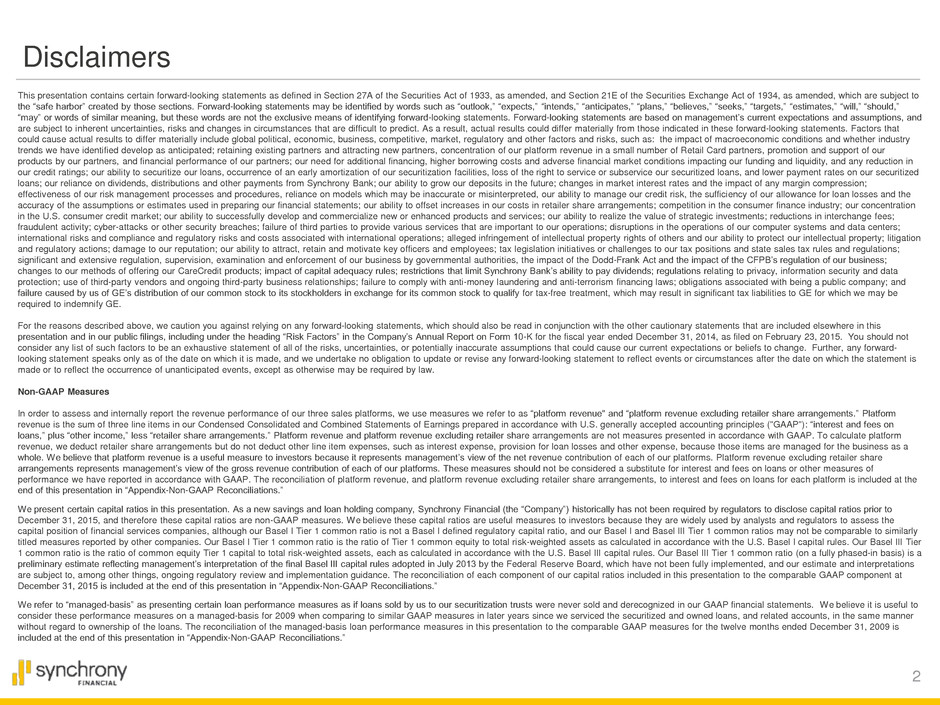
2 This presentation contains certain forward-looking statements as defined in Section 27A of the Securities Act of 1933, as amended, and Section 21E of the Securities Exchange Act of 1934, as amended, which are subject to the “safe harbor” created by those sections. Forward-looking statements may be identified by words such as “outlook,” “expects,” “intends,” “anticipates,” “plans,” “believes,” “seeks,” “targets,” “estimates,” “will,” “should,” “may” or words of similar meaning, but these words are not the exclusive means of identifying forward-looking statements. Forward-looking statements are based on management’s current expectations and assumptions, and are subject to inherent uncertainties, risks and changes in circumstances that are difficult to predict. As a result, actual results could differ materially from those indicated in these forward-looking statements. Factors that could cause actual results to differ materially include global political, economic, business, competitive, market, regulatory and other factors and risks, such as: the impact of macroeconomic conditions and whether industry trends we have identified develop as anticipated; retaining existing partners and attracting new partners, concentration of our platform revenue in a small number of Retail Card partners, promotion and support of our products by our partners, and financial performance of our partners; our need for additional financing, higher borrowing costs and adverse financial market conditions impacting our funding and liquidity, and any reduction in our credit ratings; our ability to securitize our loans, occurrence of an early amortization of our securitization facilities, loss of the right to service or subservice our securitized loans, and lower payment rates on our securitized loans; our reliance on dividends, distributions and other payments from Synchrony Bank; our ability to grow our deposits in the future; changes in market interest rates and the impact of any margin compression; effectiveness of our risk management processes and procedures, reliance on models which may be inaccurate or misinterpreted, our ability to manage our credit risk, the sufficiency of our allowance for loan losses and the accuracy of the assumptions or estimates used in preparing our financial statements; our ability to offset increases in our costs in retailer share arrangements; competition in the consumer finance industry; our concentration in the U.S. consumer credit market; our ability to successfully develop and commercialize new or enhanced products and services; our ability to realize the value of strategic investments; reductions in interchange fees; fraudulent activity; cyber-attacks or other security breaches; failure of third parties to provide various services that are important to our operations; disruptions in the operations of our computer systems and data centers; international risks and compliance and regulatory risks and costs associated with international operations; alleged infringement of intellectual property rights of others and our ability to protect our intellectual property; litigation and regulatory actions; damage to our reputation; our ability to attract, retain and motivate key officers and employees; tax legislation initiatives or challenges to our tax positions and state sales tax rules and regulations; significant and extensive regulation, supervision, examination and enforcement of our business by governmental authorities, the impact of the Dodd-Frank Act and the impact of the CFPB’s regulation of our business; changes to our methods of offering our CareCredit products; impact of capital adequacy rules; restrictions that limit Synchrony Bank’s ability to pay dividends; regulations relating to privacy, information security and data protection; use of third-party vendors and ongoing third-party business relationships; failure to comply with anti-money laundering and anti-terrorism financing laws; obligations associated with being a public company; and failure caused by us of GE’s distribution of our common stock to its stockholders in exchange for its common stock to qualify for tax-free treatment, which may result in significant tax liabilities to GE for which we may be required to indemnify GE. For the reasons described above, we caution you against relying on any forward-looking statements, which should also be read in conjunction with the other cautionary statements that are included elsewhere in this presentation and in our public filings, including under the heading “Risk Factors” in the Company’s Annual Report on Form 10-K for the fiscal year ended December 31, 2014, as filed on February 23, 2015. You should not consider any list of such factors to be an exhaustive statement of all of the risks, uncertainties, or potentially inaccurate assumptions that could cause our current expectations or beliefs to change. Further, any forward- looking statement speaks only as of the date on which it is made, and we undertake no obligation to update or revise any forward-looking statement to reflect events or circumstances after the date on which the statement is made or to reflect the occurrence of unanticipated events, except as otherwise may be required by law. Non-GAAP Measures In order to assess and internally report the revenue performance of our three sales platforms, we use measures we refer to as “platform revenue" and “platform revenue excluding retailer share arrangements.” Platform revenue is the sum of three line items in our Condensed Consolidated and Combined Statements of Earnings prepared in accordance with U.S. generally accepted accounting principles ("GAAP"): “interest and fees on loans,” plus “other income,” less “retailer share arrangements.” Platform revenue and platform revenue excluding retailer share arrangements are not measures presented in accordance with GAAP. To calculate platform revenue, we deduct retailer share arrangements but do not deduct other line item expenses, such as interest expense, provision for loan losses and other expense, because those items are managed for the business as a whole. We believe that platform revenue is a useful measure to investors because it represents management’s view of the net revenue contribution of each of our platforms. Platform revenue excluding retailer share arrangements represents management’s view of the gross revenue contribution of each of our platforms. These measures should not be considered a substitute for interest and fees on loans or other measures of performance we have reported in accordance with GAAP. The reconciliation of platform revenue, and platform revenue excluding retailer share arrangements, to interest and fees on loans for each platform is included at the end of this presentation in “Appendix-Non-GAAP Reconciliations.” We present certain capital ratios in this presentation. As a new savings and loan holding company, Synchrony Financial (the “Company”) historically has not been required by regulators to disclose capital ratios prior to December 31, 2015, and therefore these capital ratios are non-GAAP measures. We believe these capital ratios are useful measures to investors because they are widely used by analysts and regulators to assess the capital position of financial services companies, although our Basel I Tier 1 common ratio is not a Basel I defined regulatory capital ratio, and our Basel I and Basel III Tier 1 common ratios may not be comparable to similarly titled measures reported by other companies. Our Basel I Tier 1 common ratio is the ratio of Tier 1 common equity to total risk-weighted assets as calculated in accordance with the U.S. Basel I capital rules. Our Basel III Tier 1 common ratio is the ratio of common equity Tier 1 capital to total risk-weighted assets, each as calculated in accordance with the U.S. Basel III capital rules. Our Basel III Tier 1 common ratio (on a fully phased-in basis) is a preliminary estimate reflecting management’s interpretation of the final Basel III capital rules adopted in July 2013 by the Federal Reserve Board, which have not been fully implemented, and our estimate and interpretations are subject to, among other things, ongoing regulatory review and implementation guidance. The reconciliation of each component of our capital ratios included in this presentation to the comparable GAAP component at December 31, 2015 is included at the end of this presentation in “Appendix-Non-GAAP Reconciliations.” We refer to “managed-basis” as presenting certain loan performance measures as if loans sold by us to our securitization trusts were never sold and derecognized in our GAAP financial statements. We believe it is useful to consider these performance measures on a managed-basis for 2009 when comparing to similar GAAP measures in later years since we serviced the securitized and owned loans, and related accounts, in the same manner without regard to ownership of the loans. The reconciliation of the managed-basis loan performance measures in this presentation to the comparable GAAP measures for the twelve months ended December 31, 2009 is included at the end of this presentation in “Appendix-Non-GAAP Reconciliations.” Disclaimers

3 Synchrony Financial Overview Strong Value Proposition for Partners and Consumers • Advanced data analytics and targeted marketing capabilities • Dedicated team members support partners to help maximize program effectiveness • Enhanced sales growth and additional economic benefits for partners • Access to instant credit, promotional financing, and rewards for customers Attractive Growth and Ample Opportunities • Strong receivables growth • Significant opportunity to leverage long- standing partnerships to increase penetration • Opportunity to attract new partners • Developing broad product suite to build a leading, full-scale online bank Strong Financial Profile and Operating Performance • Solid fundamentals with attractive returns • Strong capital and liquidity with diverse funding profile • Positioned for future capital return subject to Board and regulatory approvals Leading Consumer Finance Business • Largest Private Label Credit Card (PLCC) provider in US(a) • A leader in financing for major consumer purchases and healthcare services • Long-standing and diverse partner base (a) Source: The Nilson Report (April 2015, Issue #1062) as measured by PLCC purchase volume and receivables, based on 2014 data. Robust Data and Technology Capabilities • Deep partner integration enables customized loyalty products across channels • Partner and cardholder focused mobile payments and e-commerce solutions • Leveraging digital, loyalty, and analytics capabilities to augment growth

Business Overview
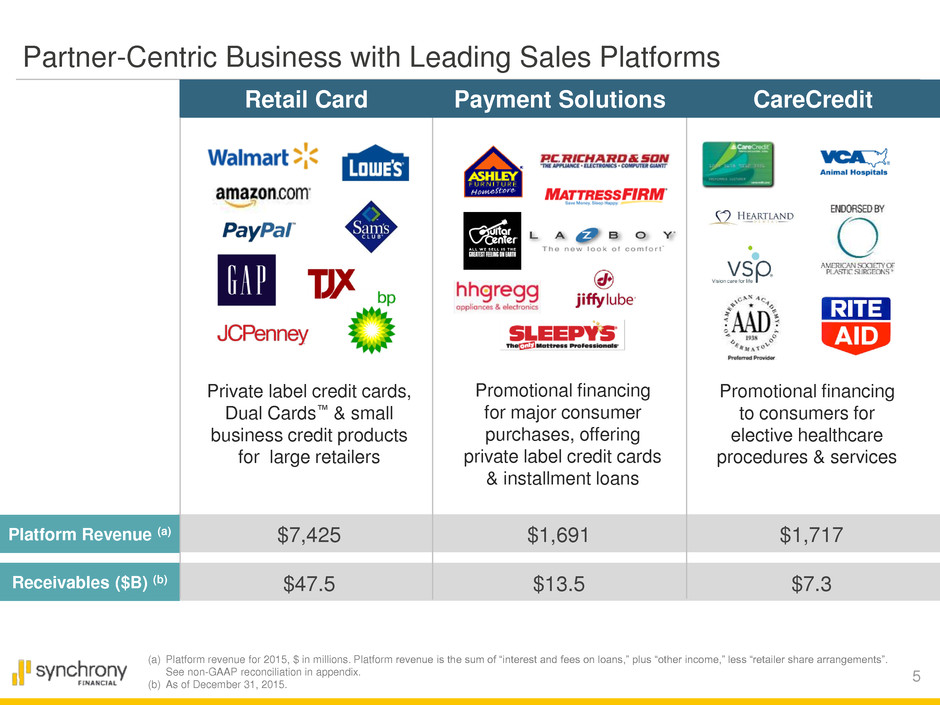
5 Partner-Centric Business with Leading Sales Platforms (a) Platform revenue for 2015, $ in millions. Platform revenue is the sum of “interest and fees on loans,” plus “other income,” less “retailer share arrangements”. See non-GAAP reconciliation in appendix. (b) As of December 31, 2015. $7,425 $47.5 $1,691 $13.5 $1,717 $7.3 Payment Solutions Retail Card CareCredit Platform Revenue (a) Receivables ($B) (b) Private label credit cards, Dual Cards™ & small business credit products for large retailers Promotional financing for major consumer purchases, offering private label credit cards & installment loans Promotional financing to consumers for elective healthcare procedures & services

6 Customized Products Credit Products Retailer only acceptance Accepted at network locations Deposit Products Retailer only acceptance Accepted at provider network locations Private Label Dual CardTM Affinity to retailer, provides customized benefits & features Big-ticket focus, offering promotional financing options Retail Card Private Label Private Label • Dental • Vision • Cosmetic • Veterinary • Cash back, discounts • Credit events & promotions • Reward/best customer programs • Home • Furniture • Electronics • Luxury • Power sports Payment Solutions CareCredit Fast-growing online bank Deposits FDIC-insured products Robust product suite Synchrony Bank • Certificates of Deposit • Money Market Accounts • Savings Accounts • IRA Money Market Accounts • IRA Certificates of Deposit
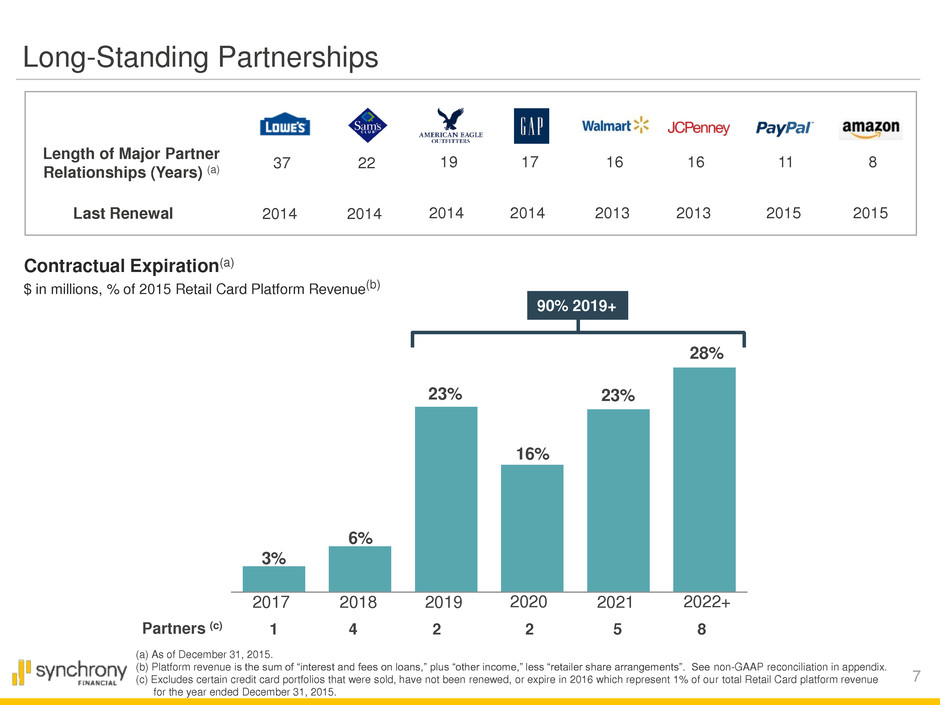
7 26% Long-Standing Partnerships (a) As of December 31, 2015. (b) Platform revenue is the sum of “interest and fees on loans,” plus “other income,” less “retailer share arrangements”. See non-GAAP reconciliation in appendix. (c) Excludes certain credit card portfolios that were sold, have not been renewed, or expire in 2016 which represent 1% of our total Retail Card platform revenue for the year ended December 31, 2015. 3% 6% 23% Partners (c) 16% 23% 2019 2018 2017 2021 1 4 2 2 2020 28% 2022+ 5 8 Length of Major Partner Relationships (Years) (a) Last Renewal 37 2014 22 2014 19 2014 17 2014 16 2013 16 2013 11 2015 8 2015 90% 2019+ Contractual Expiration(a) $ in millions, % of 2015 Retail Card Platform Revenue(b)
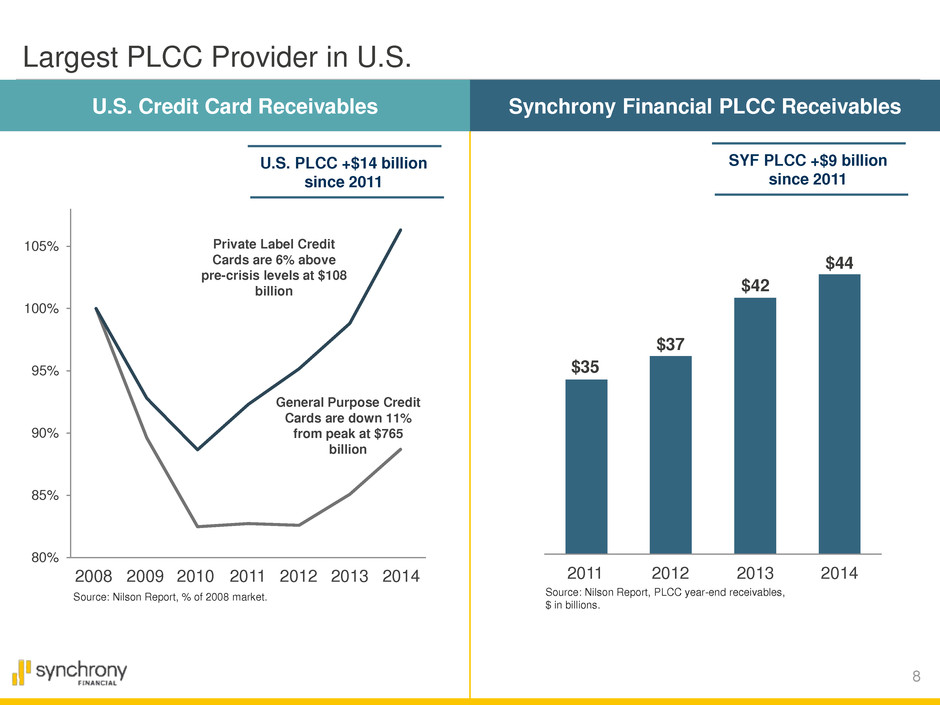
8 Largest PLCC Provider in U.S. Source: Nilson Report, % of 2008 market. 80% 85% 90% 95% 100% 105% Private Label Credit Cards are 6% above pre-crisis levels at $108 billion General Purpose Credit Cards are down 11% from peak at $765 billion 2008 2009 2010 2011 2012 2013 Source: Nilson Report, PLCC year-end receivables, $ in billions. $42 $35 $37 U.S. PLCC +$14 billion since 2011 2014 2011 2012 $44 2014 2013 U.S. Credit Card Receivables Synchrony Financial PLCC Receivables SYF PLCC +$9 billion since 2011
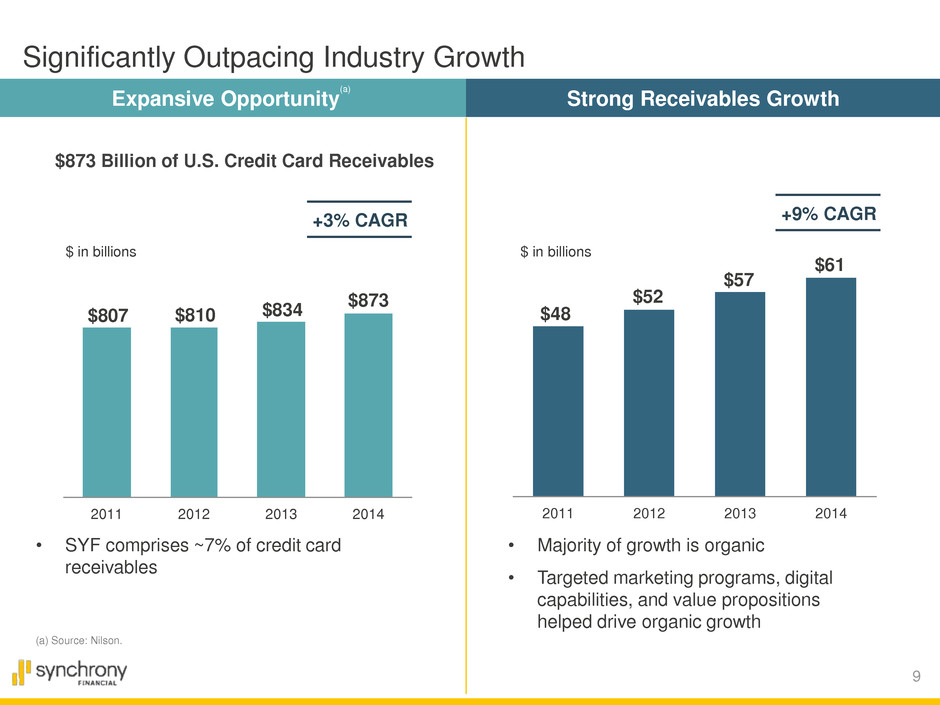
9 Expansive Opportunity (a) (a) Source: Nilson. $873 Billion of U.S. Credit Card Receivables $48 $52 $57 $61 2011 2012 2013 2014 $ in billions • Majority of growth is organic • Targeted marketing programs, digital capabilities, and value propositions helped drive organic growth Strong Receivables Growth $807 $810 $834 $873 2011 2012 2013 2014 +3% CAGR +9% CAGR • SYF comprises ~7% of credit card receivables Significantly Outpacing Industry Growth $ in billions
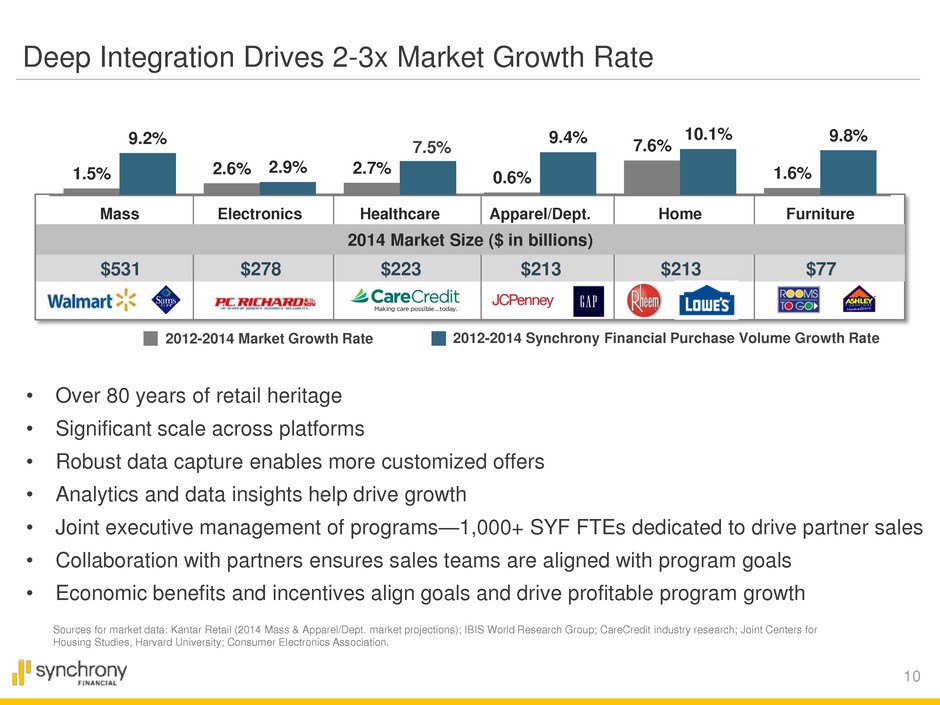
10 1.5% 2.6% 2.7% 0.6% 7.6% 1.6% 9.2% 2.9% 7.5% 9.4% 10.1% 9.8% Mass Electronics Healthcare Apparel/Dept. Home Furniture $531 $278 $223 $213 $213 $77 2012-2014 Market Growth Rate 2012-2014 Synchrony Financial Purchase Volume Growth Rate 2014 Market Size ($ in billions) • Over 80 years of retail heritage • Significant scale across platforms • Robust data capture enables more customized offers • Analytics and data insights help drive growth • Joint executive management of programs—1,000+ SYF FTEs dedicated to drive partner sales • Collaboration with partners ensures sales teams are aligned with program goals • Economic benefits and incentives align goals and drive profitable program growth Deep Integration Drives 2-3x Market Growth Rate Sources for market data: Kantar Retail (2014 Mass & Apparel/Dept. market projections); IBIS World Research Group; CareCredit industry research; Joint Centers for Housing Studies, Harvard University; Consumer Electronics Association.
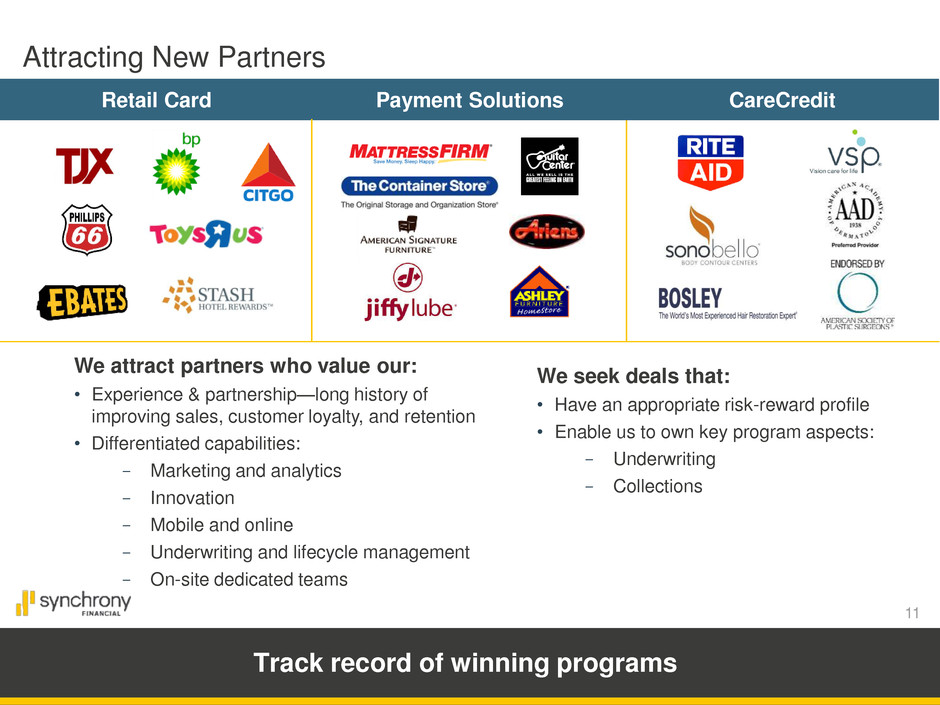
11 11 Retail Card Payment Solutions We attract partners who value our: • Experience & partnership—long history of improving sales, customer loyalty, and retention • Differentiated capabilities: - Marketing and analytics - Innovation - Mobile and online - Underwriting and lifecycle management - On-site dedicated teams We seek deals that: • Have an appropriate risk-reward profile • Enable us to own key program aspects: - Underwriting - Collections Attracting New Partners Track record of winning programs CareCredit
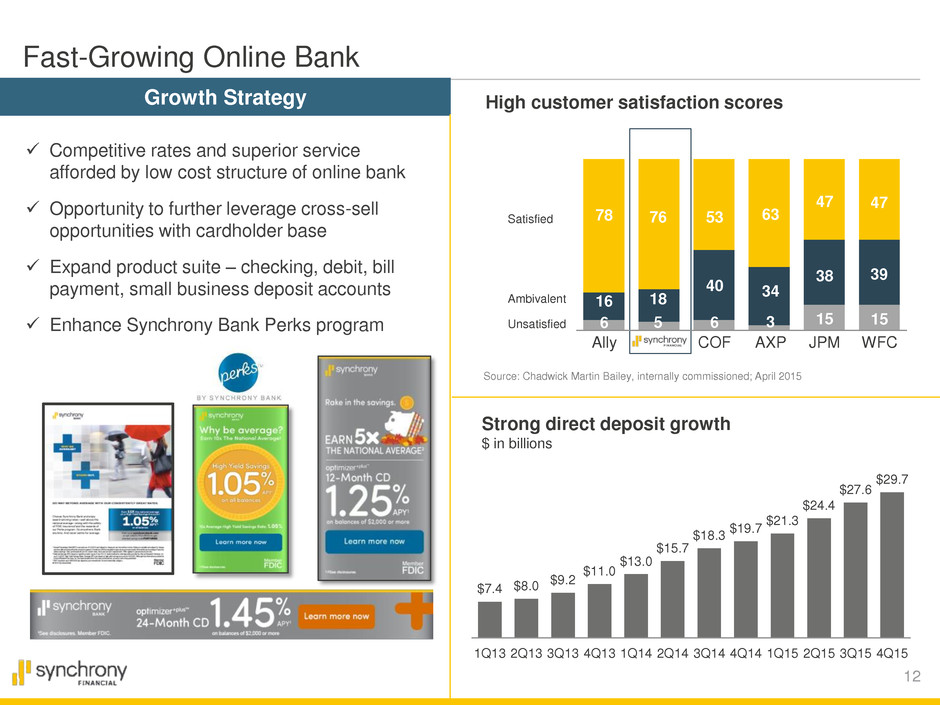
12 $7.4 $8.0 $9.2 $11.0 $13.0 $15.7 $18.3 $19.7 $21.3 $24.4 $27.6 $29.7 1Q13 2Q13 3Q13 4Q13 1Q14 2Q14 3Q14 4Q14 1Q15 2Q15 3Q15 4Q15 Growth Strategy Competitive rates and superior service afforded by low cost structure of online bank Opportunity to further leverage cross-sell opportunities with cardholder base Expand product suite – checking, debit, bill payment, small business deposit accounts Enhance Synchrony Bank Perks program High customer satisfaction scores Ally Source: Chadwick Martin Bailey, internally commissioned; April 2015 78 16 6 76 18 5 63 34 3 47 38 15 47 39 15 Satisfied Ambivalent Unsatisfied 53 40 6 AXP WFC JPM COF Strong direct deposit growth $ in billions Fast-Growing Online Bank

Robust Data, Analytics and Digital Capabilities
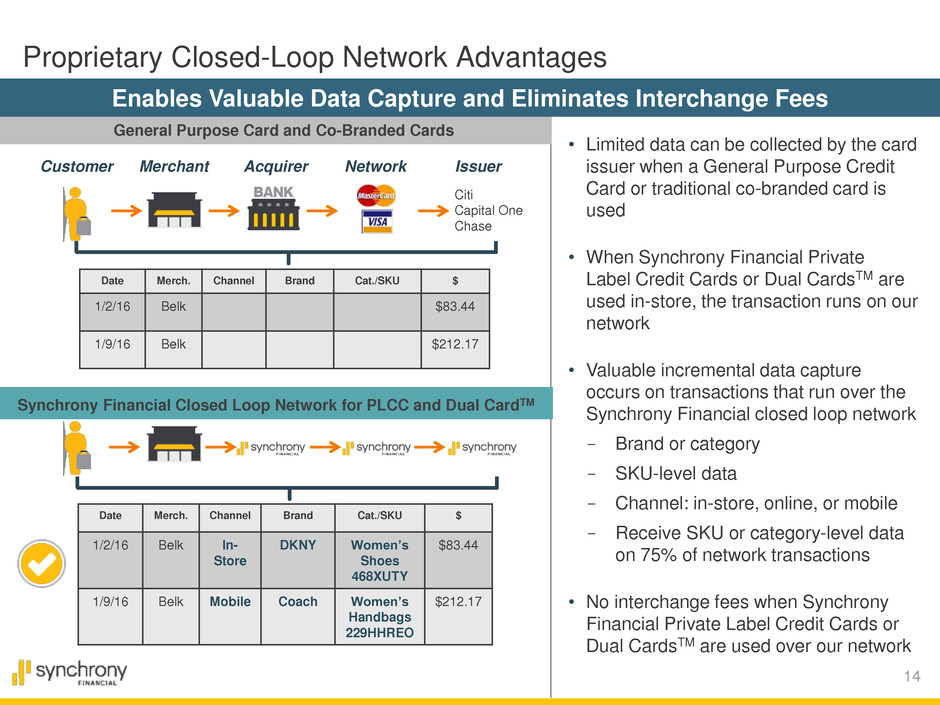
14 Proprietary Closed-Loop Network Advantages Customer Merchant Acquirer Network Issuer General Purpose Card and Co-Branded Cards Synchrony Financial Closed Loop Network for PLCC and Dual CardTM Citi Capital One Chase Date Merch. Channel Brand Cat./SKU $ 1/2/16 Belk In- Store DKNY Women’s Shoes 468XUTY $83.44 1/9/16 Belk Mobile Coach Women’s Handbags 229HHREO $212.17 Date Merch. Channel Brand Cat./SKU $ 1/2/16 Belk $83.44 1/9/16 Belk $212.17 Enables Valuable Data Capture and Eliminates Interchange Fees • Limited data can be collected by the card issuer when a General Purpose Credit Card or traditional co-branded card is used • When Synchrony Financial Private Label Credit Cards or Dual CardsTM are used in-store, the transaction runs on our network • Valuable incremental data capture occurs on transactions that run over the Synchrony Financial closed loop network - Brand or category - SKU-level data - Channel: in-store, online, or mobile - Receive SKU or category-level data on 75% of network transactions • No interchange fees when Synchrony Financial Private Label Credit Cards or Dual CardsTM are used over our network
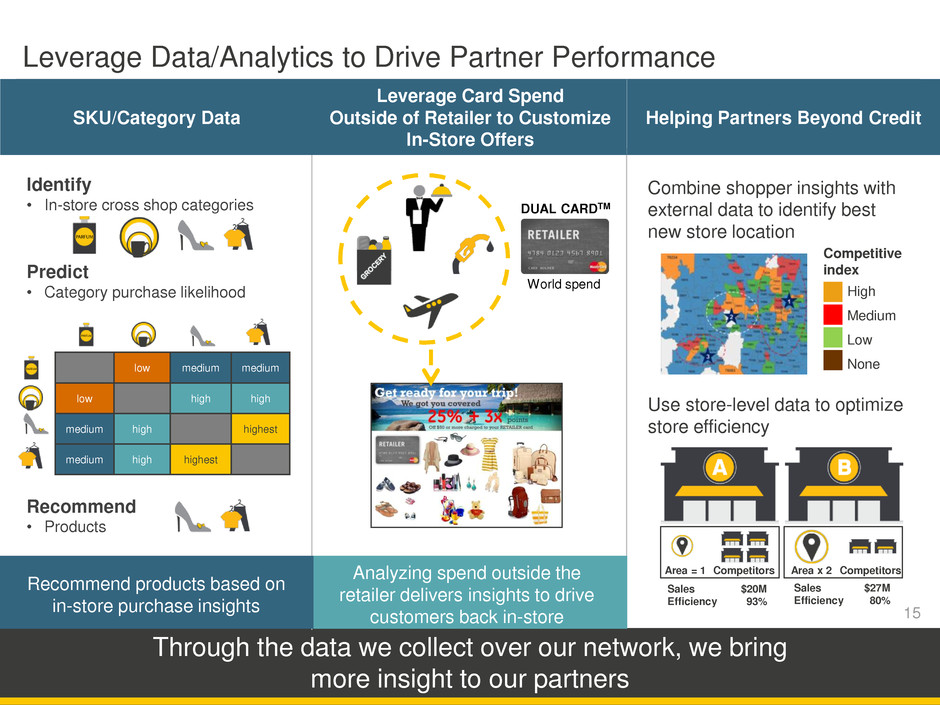
15 15 SKU/Category Data Leverage Data/Analytics to Drive Partner Performance Through the data we collect over our network, we bring more insight to our partners DUAL CARDTM World spend Analyzing spend outside the retailer delivers insights to drive customers back in-store Combine shopper insights with external data to identify best new store location Use store-level data to optimize store efficiency Recommend products based on in-store purchase insights Identify • In-store cross shop categories Predict • Category purchase likelihood Recommend • Products Leverage Card Spend Outside of Retailer to Customize In-Store Offers Helping Partners Beyond Credit low medium medium low high high medium high highest medium high highest High Medium Low None Competitive index Area = 1 Area x 2 Competitors Competitors Sales $20M Efficiency 93% Sales $27M Efficiency 80%
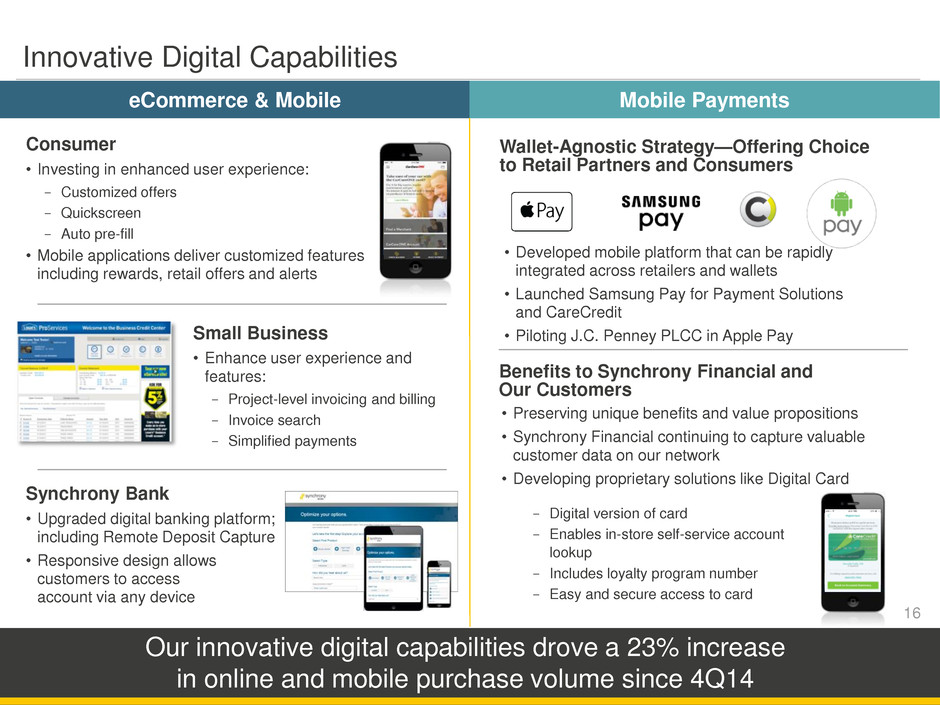
16 16 eCommerce & Mobile Innovative Digital Capabilities Our innovative digital capabilities drove a 23% increase in online and mobile purchase volume since 4Q14 Mobile Payments Consumer • Investing in enhanced user experience: - Customized offers - Quickscreen - Auto pre-fill • Mobile applications deliver customized features including rewards, retail offers and alerts Wallet-Agnostic Strategy—Offering Choice to Retail Partners and Consumers Small Business • Enhance user experience and features: - Project-level invoicing and billing - Invoice search - Simplified payments Synchrony Bank • Upgraded digital banking platform; including Remote Deposit Capture • Responsive design allows customers to access account via any device - Digital version of card - Enables in-store self-service account lookup - Includes loyalty program number - Easy and secure access to card Benefits to Synchrony Financial and Our Customers • Preserving unique benefits and value propositions • Synchrony Financial continuing to capture valuable customer data on our network • Developing proprietary solutions like Digital Card • Developed mobile platform that can be rapidly integrated across retailers and wallets • Launched Samsung Pay for Payment Solutions and CareCredit • Piloting J.C. Penney PLCC in Apple Pay

Financial Performance & Business Highlights
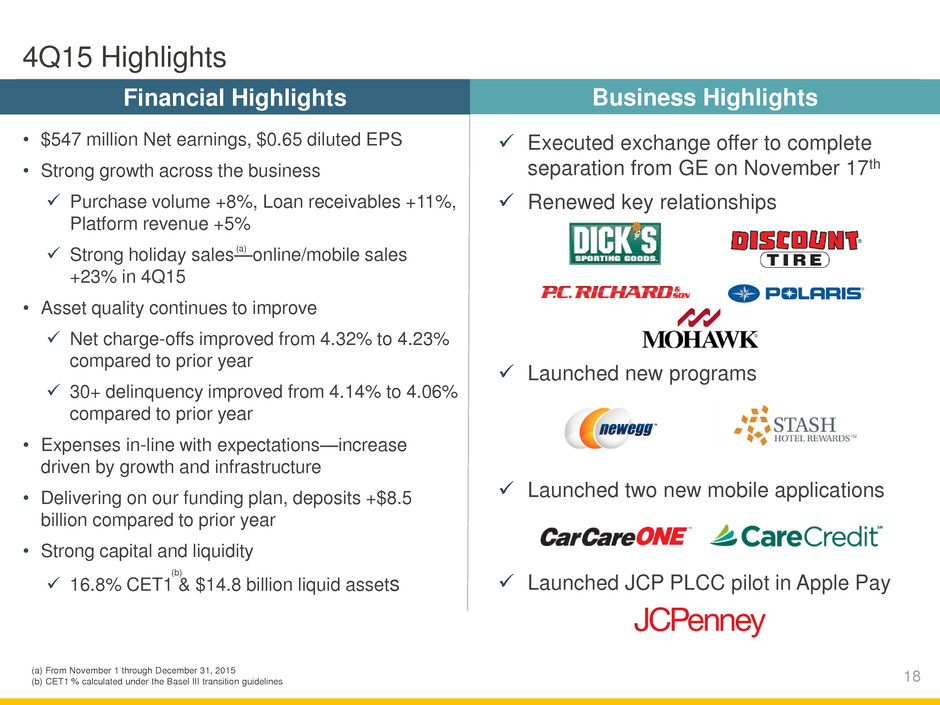
18 4Q15 Highlights Financial Highlights Business Highlights • $547 million Net earnings, $0.65 diluted EPS • Strong growth across the business Purchase volume +8%, Loan receivables +11%, Platform revenue +5% Strong holiday sales—online/mobile sales +23% in 4Q15 • Asset quality continues to improve Net charge-offs improved from 4.32% to 4.23% compared to prior year 30+ delinquency improved from 4.14% to 4.06% compared to prior year • Expenses in-line with expectations—increase driven by growth and infrastructure • Delivering on our funding plan, deposits +$8.5 billion compared to prior year • Strong capital and liquidity 16.8% CET1 & $14.8 billion liquid assets Launched two new mobile applications Launched JCP PLCC pilot in Apple Pay Executed exchange offer to complete separation from GE on November 17th Renewed key relationships Launched new programs (a) From November 1 through December 31, 2015 (b) CET1 % calculated under the Basel III transition guidelines (a) (b)

19 $2,109 $2,214 4.51% 4.33% Net Earnings $ in millions 2014 2015 Loan Receivables (a) $ in billions + 11% Net Charge-Offs (c) % of average loan receivables Platform Revenue (b) $ in millions $10,126 $10,833 + 7% Improved 18 bps $61.3 $68.3 2014 2015 2014 2015 2014 2015 (a) Period-end balances, 2015 includes the acquisition of the BP portfolio completed in 2Q15. (b) Platform revenue is the sum of “interest and fees on loans,” plus “other income,” less “retailer share arrangements”. See non-GAAP reconciliation in appendix. (c) Includes loan receivables held for sale. + 5% Strong Operating Performance
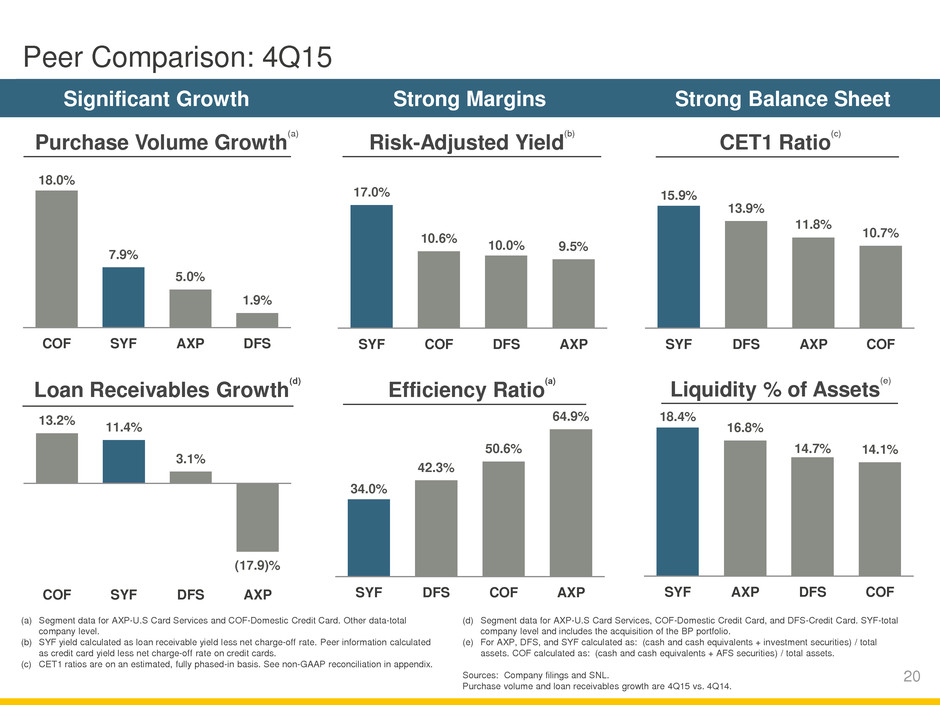
20 (a) Segment data for AXP-U.S Card Services and COF-Domestic Credit Card. Other data-total company level. (b) SYF yield calculated as loan receivable yield less net charge-off rate. Peer information calculated as credit card yield less net charge-off rate on credit cards. (c) CET1 ratios are on an estimated, fully phased-in basis. See non-GAAP reconciliation in appendix. 34.0% 42.3% 50.6% 64.9% SYF DFS COF AXP Efficiency Ratio (a) Risk-Adjusted Yield (b) 17.0% 10.6% 10.0% 9.5% SYF COF DFS AXP 18.0% 7.9% 5.0% 1.9% COF SYF AXP DFS Purchase Volume Growth (a) Liquidity % of Assets (e) 18.4% 16.8% 14.7% 14.1% SYF AXP DFS COF 15.9% 13.9% 11.8% 10.7% SYF DFS AXP COF CET1 Ratio (c) Strong Margins Significant Growth Strong Balance Sheet Loan Receivables Growth (d) 13.2% 11.4% 3.1% (17.9)% COF SYF DFS AXP (d) Segment data for AXP-U.S Card Services, COF-Domestic Credit Card, and DFS-Credit Card. SYF-total company level and includes the acquisition of the BP portfolio. (e) For AXP, DFS, and SYF calculated as: (cash and cash equivalents + investment securities) / total assets. COF calculated as: (cash and cash equivalents + AFS securities) / total assets. Sources: Company filings and SNL. Purchase volume and loan receivables growth are 4Q15 vs. 4Q14. Peer Comparison: 4Q15

21 19% 7% 20% 20% 61% 73% • Synchrony Financial controls underwriting and credit line decisions • Focus on stronger underwriting has led to higher quality portfolio - 73% of loan receivables have FICO > 660 Stronger Portfolio U.S. consumer FICO (a) Delinquency Performance 30+ days past due as a % of period-end loan receivables 4.35% 4.14% 4.06% 4Q15 4Q14 4Q13 (a) Prior to 3Q12 a proprietary scoring model was used and converted to a FICO equivalent score. 4.58% 4Q12 601-660 661+ 2008 4Q15 ≤ 600 ≤ 600 601-660 661-720 721+ At origination Disciplined Underwriting FICO, consumer accounts opened since beginning of 2010 40% 38% 21% 1% Focus on Higher Quality Asset Base
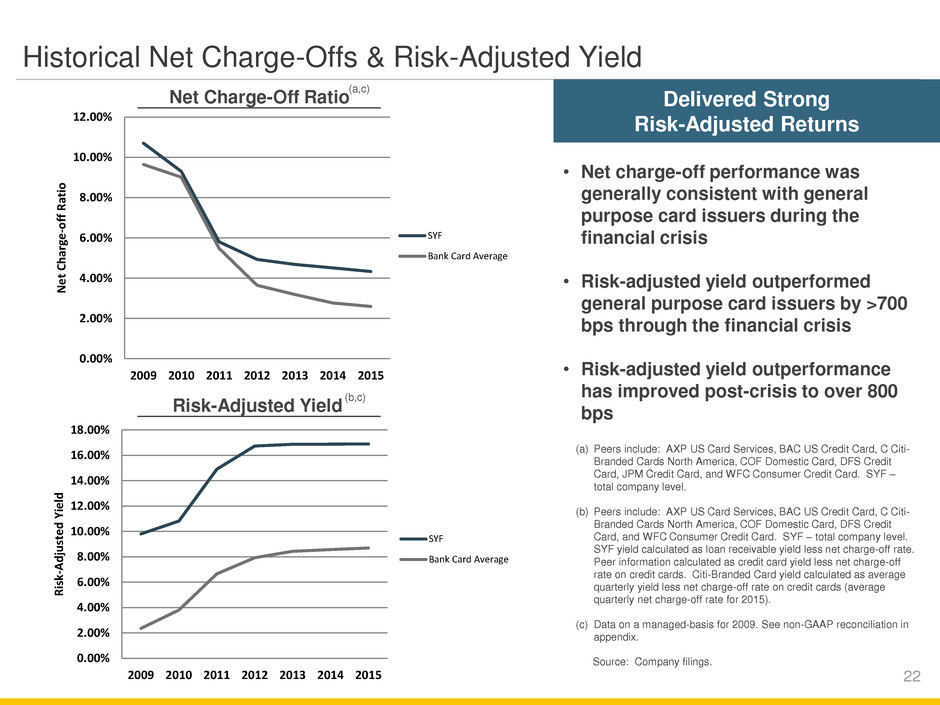
22 Net Charge-Off Ratio Risk-Adjusted Yield (a) Peers include: AXP US Card Services, BAC US Credit Card, C Citi- Branded Cards North America, COF Domestic Card, DFS Credit Card, JPM Credit Card, and WFC Consumer Credit Card. SYF – total company level. (b) Peers include: AXP US Card Services, BAC US Credit Card, C Citi- Branded Cards North America, COF Domestic Card, DFS Credit Card, and WFC Consumer Credit Card. SYF – total company level. SYF yield calculated as loan receivable yield less net charge-off rate. Peer information calculated as credit card yield less net charge-off rate on credit cards. Citi-Branded Card yield calculated as average quarterly yield less net charge-off rate on credit cards (average quarterly net charge-off rate for 2015). (c) Data on a managed-basis for 2009. See non-GAAP reconciliation in appendix. (a,c) (b,c) • Net charge-off performance was generally consistent with general purpose card issuers during the financial crisis • Risk-adjusted yield outperformed general purpose card issuers by >700 bps through the financial crisis • Risk-adjusted yield outperformance has improved post-crisis to over 800 bps Delivered Strong Risk-Adjusted Returns Historical Net Charge-Offs & Risk-Adjusted Yield Source: Company filings. 0.00% 2.00% 4.00% 6.00% 8.00% 10.00% 12.00% 2009 2010 2011 2012 2013 2014 2015 N e t C h ar ge -o ff R ati o SYF Bank Card Average 0.00% 2.00% 4.00% 6.00% 8.00% 10.00% 12.00% 14.00% 16.00% 18.00% 2009 2010 2011 2012 2013 2014 2015 R is k- A d ju st e d Y ie ld SYF Bank Card Average
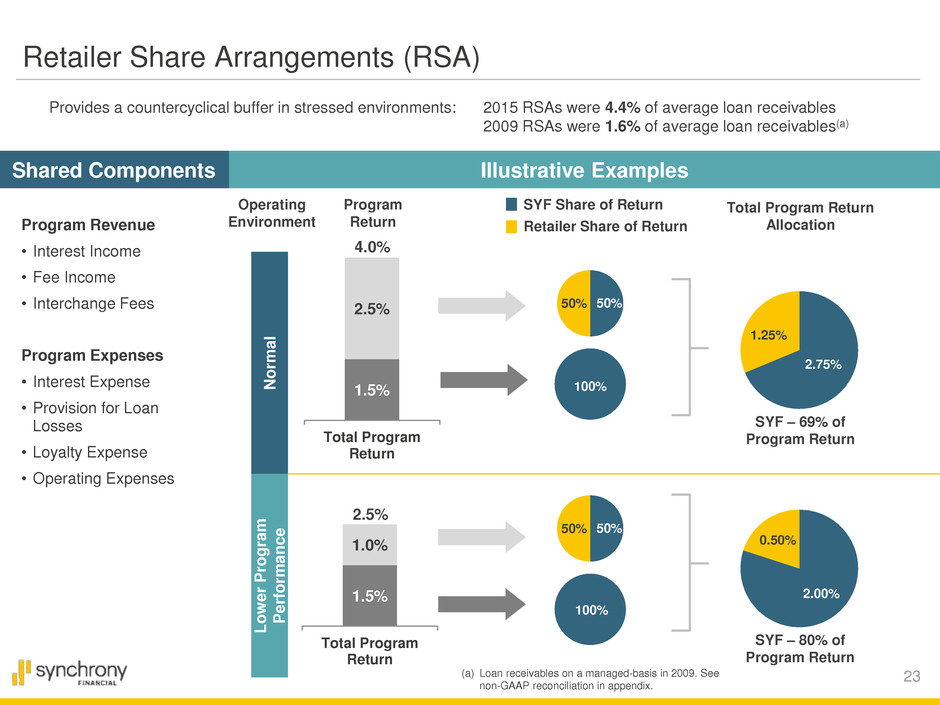
23 100% 50% 50% 1.5% 2.5% Total Program Return Shared Components Illustrative Examples Program Revenue • Interest Income • Fee Income • Interchange Fees Program Expenses • Interest Expense • Provision for Loan Losses • Loyalty Expense • Operating Expenses SYF Share of Return Retailer Share of Return 2.75% 1.25% 4.0% Total Program Return Allocation Provides a countercyclical buffer in stressed environments: 2015 RSAs were 4.4% of average loan receivables 2009 RSAs were 1.6% of average loan receivables(a) 100% 50% 50% 1.5% 1.0% Total Program Return 2.00% 0.50% 2.5% N orma l Lo w e r P rogr a m P e rf o rm a nc e Operating Environment Program Return (a) Loan receivables on a managed-basis in 2009. See non-GAAP reconciliation in appendix. Retailer Share Arrangements (RSA) SYF – 69% of Program Return SYF – 80% of Program Return
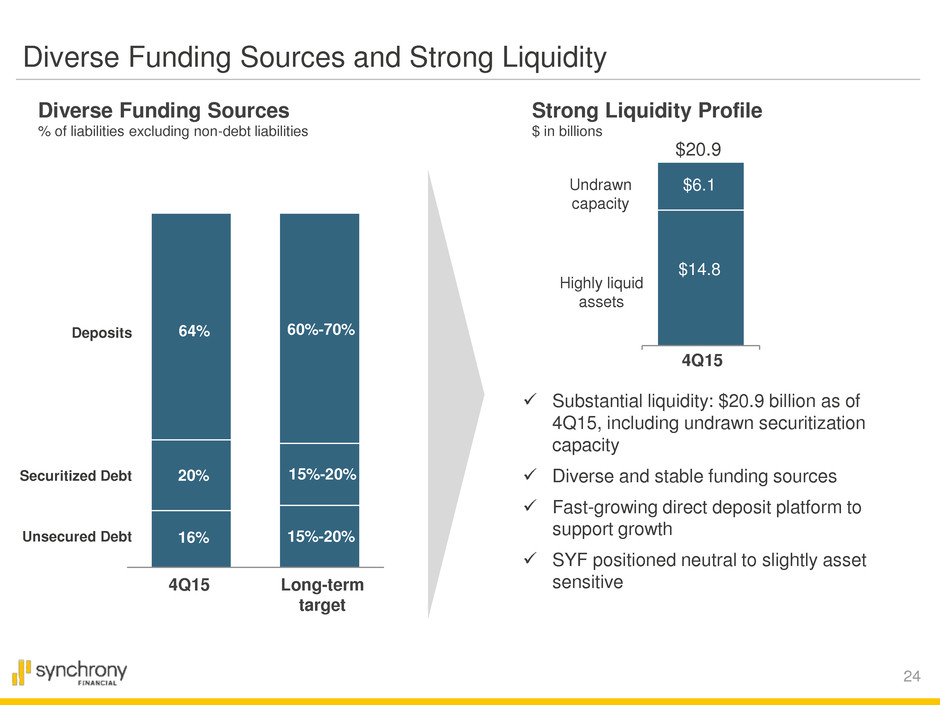
24 Diverse Funding Sources and Strong Liquidity Deposits Securitized Debt Unsecured Debt 4Q15 Long-term target 16% 64% 20% 15%-20% 60%-70% 15%-20% Diverse Funding Sources % of liabilities excluding non-debt liabilities Strong Liquidity Profile $ in billions $20.9 Highly liquid assets Undrawn capacity $6.1 $14.8 Substantial liquidity: $20.9 billion as of 4Q15, including undrawn securitization capacity Diverse and stable funding sources Fast-growing direct deposit platform to support growth SYF positioned neutral to slightly asset sensitive 4Q15
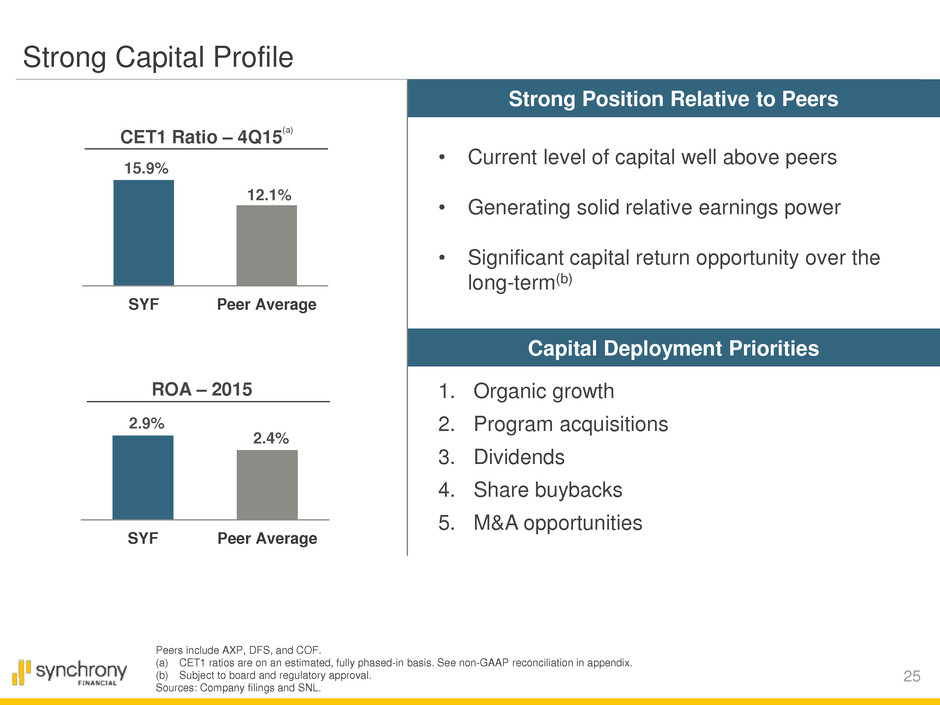
25 Strong Position Relative to Peers Strong Capital Profile Peers include AXP, DFS, and COF. (a) CET1 ratios are on an estimated, fully phased-in basis. See non-GAAP reconciliation in appendix. (b) Subject to board and regulatory approval. Sources: Company filings and SNL. 2.9% 2.4% SYF Peer Average ROA – 2015 15.9% 12.1% SYF Peer Average CET1 Ratio – 4Q15 (a) • Current level of capital well above peers • Generating solid relative earnings power • Significant capital return opportunity over the long-term(b) Capital Deployment Priorities 1. Organic growth 2. Program acquisitions 3. Dividends 4. Share buybacks 5. M&A opportunities
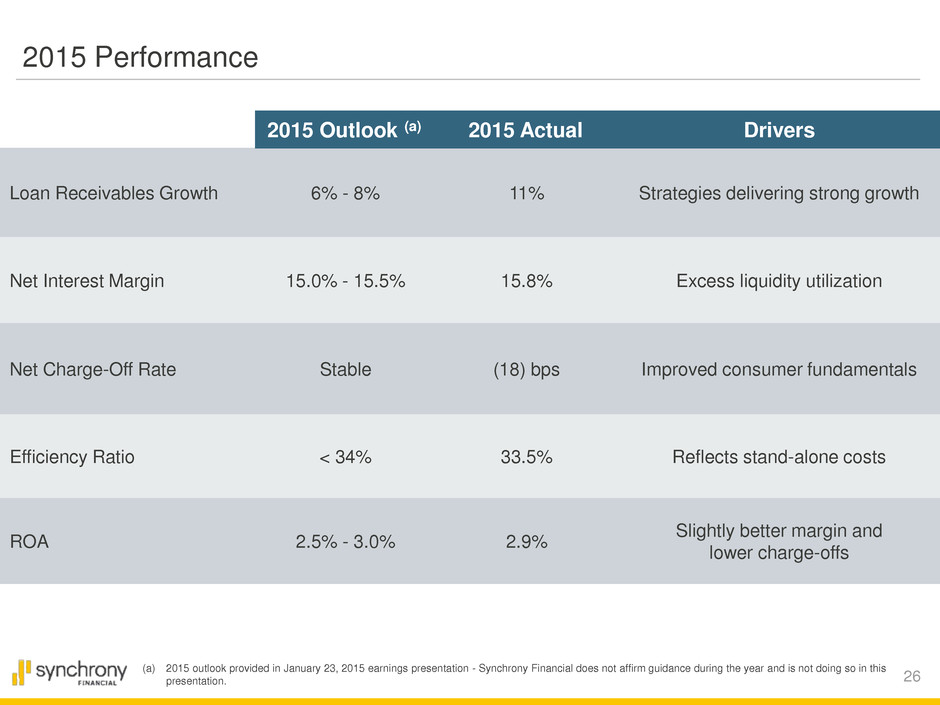
26 2015 Performance Loan Receivables Growth 6% - 8% 11% Strategies delivering strong growth Net Interest Margin 15.0% - 15.5% 15.8% Excess liquidity utilization Net Charge-Off Rate Stable (18) bps Improved consumer fundamentals Efficiency Ratio < 34% 33.5% Reflects stand-alone costs ROA 2.5% - 3.0% 2.9% Slightly better margin and lower charge-offs 2015 Outlook (a) 2015 Actual Drivers (a) 2015 outlook provided in January 23, 2015 earnings presentation - Synchrony Financial does not affirm guidance during the year and is not doing so in this presentation.
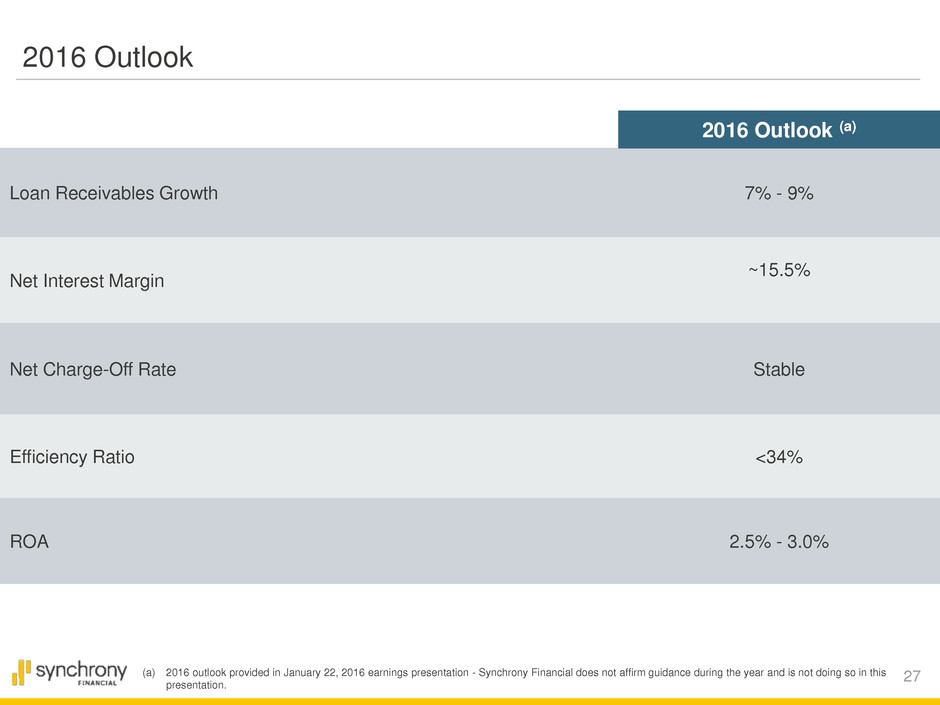
27 2016 Outlook Loan Receivables Growth 7% - 9% Net Interest Margin ~15.5% Net Charge-Off Rate Stable Efficiency Ratio <34% ROA 2.5% - 3.0% 2016 Outlook (a) (a) 2016 outlook provided in January 22, 2016 earnings presentation - Synchrony Financial does not affirm guidance during the year and is not doing so in this presentation.
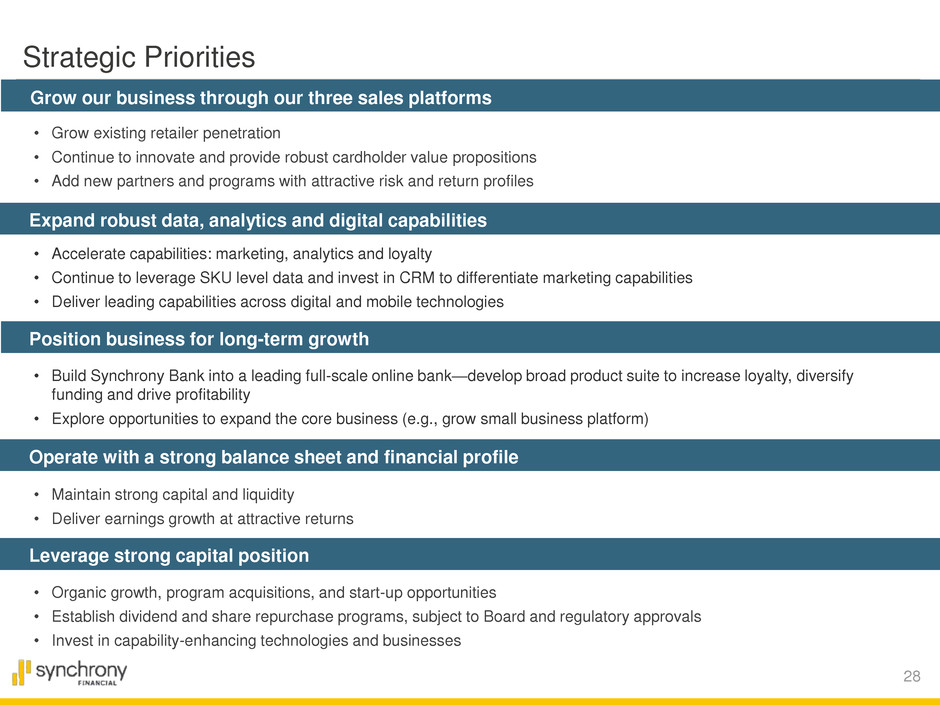
28 Strategic Priorities Grow our business through our three sales platforms Position business for long-term growth Operate with a strong balance sheet and financial profile Leverage strong capital position Expand robust data, analytics and digital capabilities • Grow existing retailer penetration • Continue to innovate and provide robust cardholder value propositions • Add new partners and programs with attractive risk and return profiles • Accelerate capabilities: marketing, analytics and loyalty • Continue to leverage SKU level data and invest in CRM to differentiate marketing capabilities • Deliver leading capabilities across digital and mobile technologies • Build Synchrony Bank into a leading full-scale online bank—develop broad product suite to increase loyalty, diversify funding and drive profitability • Explore opportunities to expand the core business (e.g., grow small business platform) • Maintain strong capital and liquidity • Deliver earnings growth at attractive returns • Organic growth, program acquisitions, and start-up opportunities • Establish dividend and share repurchase programs, subject to Board and regulatory approvals • Invest in capability-enhancing technologies and businesses

Appendix

30 Non-GAAP Reconciliation The following table sets forth each component of our platform revenue for periods indicated below. ($ in millions) 2015 2014 Platform Revenue Total: Interest and fees on loans . . . . . . . . . . . . . . . . . . . . . . . . . . . . . . . . . . . . . . . . . . . . . . . . . . . . . . . . . . . . . . $13,179 $12,216 Other income . . . . . . . . . . . . . . . . . . . . . . . . . . . . . . . . . . . . . . . . . . . . . . . . . . . . . . . . . . . . . . . . . . . . . . . . $392 $485 Retailer share arrangements . . . . . . . . . . . . . . . . . . . . . . . . . . . . . . . . . . . . . . . . . . . . . . . . . . . . . . . . . . . . $(2,738) $(2,575) Platform revenue . . . . . . . . . . . . . . . . . . . . . . . . . . . . . . . . . . . . . . . . . . . . . . . . . . . . . . . . . . . . . . . . . . . . . $10,833 $10,126 Retail Card: Interest and fees on loans . . . . . . . . . . . . . . . . . . . . . . . . . . . . . . . . . . . . . . . . . . . . . . . . . . . . . . . . . . . . . . $9,774 $9,040 Other income . . . . . . . . . . . . . . . . . . . . . . . . . . . . . . . . . . . . . . . . . . . . . . . . . . . . . . . . . . . . . . . . . . . . . . . . $339 $407 Retailer share arrangements . . . . . . . . . . . . . . . . . . . . . . . . . . . . . . . . . . . . . . . . . . . . . . . . . . . . . . . . . . . . $(2,688) $(2,530) Platform revenue . . . . . . . . . . . . . . . . . . . . . . . . . . . . . . . . . . . . . . . . . . . . . . . . . . . . . . . . . . . . . . . . . . . . . $7,425 $6,917 Payment Solutions: Interest and fees on loans . . . . . . . . . . . . . . . . . . . . . . . . . . . . . . . . . . . . . . . . . . . . . . . . . . . . . . . . . . . . . . $1,719 $1,582 Other income . . . . . . . . . . . . . . . . . . . . . . . . . . . . . . . . . . . . . . . . . . . . . . . . . . . . . . . . . . . . . . . . . . . . . . . . $17 $32 Retailer share arrangements . . . . . . . . . . . . . . . . . . . . . . . . . . . . . . . . . . . . . . . . . . . . . . . . . . . . . . . . . . . . $(45) $(41) Platform revenue . . . . . . . . . . . . . . . . . . . . . . . . . . . . . . . . . . . . . . . . . . . . . . . . . . . . . . . . . . . . . . . . . . . . . $1,691 $1,573 CareCredit: Interest and fees on loans . . . . . . . . . . . . . . . . . . . . . . . . . . . . . . . . . . . . . . . . . . . . . . . . . . . . . . . . . . . . . . $1,686 $1,594 Other income . . . . . . . . . . . . . . . . . . . . . . . . . . . . . . . . . . . . . . . . . . . . . . . . . . . . . . . . . . . . . . . . . . . . . . . . $36 $46 Retailer share arrangements . . . . . . . . . . . . . . . . . . . . . . . . . . . . . . . . . . . . . . . . . . . . . . . . . . . . . . . . . . . . $(5) $(4) Platform revenue. . . . . . . . . . . . . . . . . . . . . . . . . . . . . . . . . . . . . . . . . . . . . . . . . . . . . . . . . . . . . . . . . . . . . $1,717 $1,636 For the Twelve Months Ended December 31,
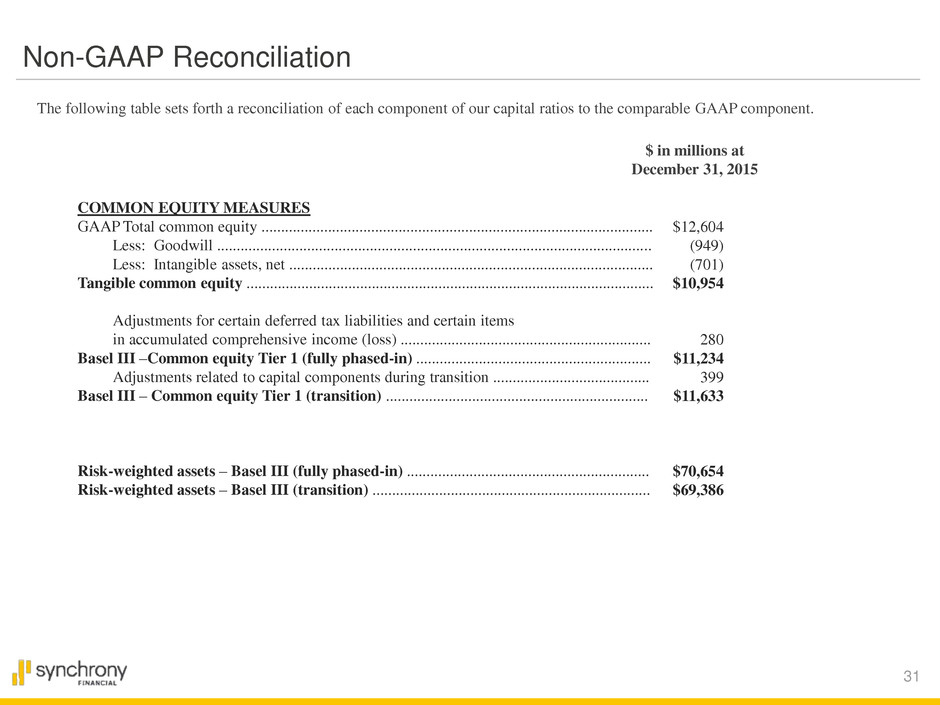
31 Non-GAAP Reconciliation The following table sets forth a reconciliation of each component of our capital ratios to the comparable GAAP component. COMMON EQUITY MEASURES GAAP Total common equity .................................................................................................... Less: Goodwill ............................................................................................................... Less: Intangible assets, net ............................................................................................. Tangible common equity ........................................................................................................ Adjustments for certain deferred tax liabilities and certain items in accumulated comprehensive income (loss) ................................................................ Basel III –Common equity Tier 1 (fully phased-in) ............................................................ Adjustments related to capital components during transition ........................................ Basel III – Common equity Tier 1 (transition) ................................................................... Risk-weighted assets – Basel III (fully phased-in) .............................................................. Risk-weighted assets – Basel III (transition) ....................................................................... $12,604 (949) (701) $10,954 280 $11,234 399 $11,633 $70,654 $69,386 $ in millions at December 31, 2015
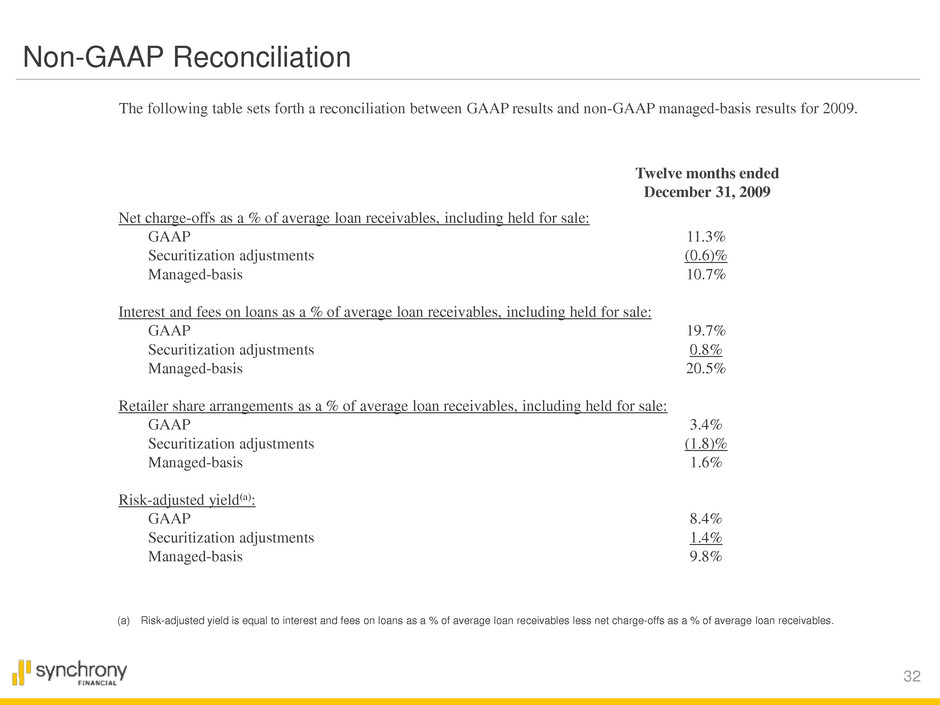
32 Non-GAAP Reconciliation The following table sets forth a reconciliation between GAAP results and non-GAAP managed-basis results for 2009. Net charge-offs as a % of average loan receivables, including held for sale: GAAP 11.3% Securitization adjustments (0.6)% Managed-basis 10.7% Interest and fees on loans as a % of average loan receivables, including held for sale: GAAP 19.7% Securitization adjustments 0.8% Managed-basis 20.5% Retailer share arrangements as a % of average loan receivables, including held for sale: GAAP 3.4% Securitization adjustments (1.8)% Managed-basis 1.6% Risk-adjusted yield(a): GAAP 8.4% Securitization adjustments 1.4% Managed-basis 9.8% Twelve months ended December 31, 2009 (a) Risk-adjusted yield is equal to interest and fees on loans as a % of average loan receivables less net charge-offs as a % of average loan receivables.
